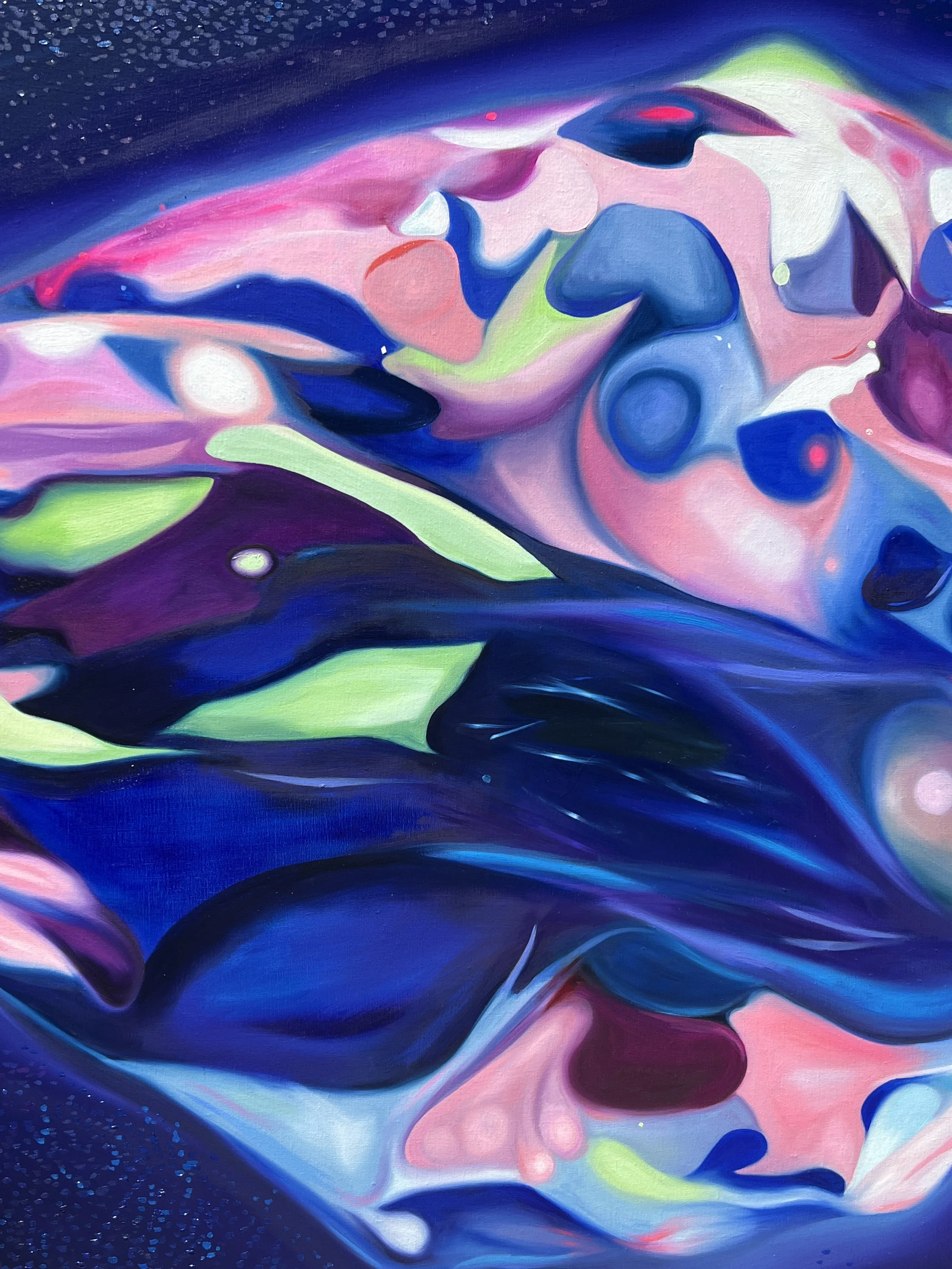Epithelial Cells, 2024
Epithelial Cells, 2024
Oil on linen
122 x 153 cm (48 x 60 in)
Epithelial Cells (2024) depicts human epithelial cells growing in a dish. The cells have been clonally labeled, meaning cells of the same color are descendants of a single cell at the time of labeling. This scientific approach helps quantify cell proliferation and reveals how proliferative potential is passed from stem cells to their differentiated daughter cells. This work encapsulates the intricate convergence of biology and technology, reflecting our socio-technological journey in the era of the Anthropocene.
The vivid colors and dynamic forms in the painting symbolize the rapid advancements in biotechnology and their implications for human life and society. By translating the microscopic beauty of epithelial cells into a large-scale oil painting, Tan Mu invites viewers to reflect on the interconnectedness of life, both at the cellular level and on a global scale.
Q: How did you come to choose epithelial cells as the subject for this work? What drew you to this particular aspect of cell biology?
Tan Mu: This work stems from my long-standing fascination with the microscopic world and my deep interest in breakthrough technologies. By marking a single cell with a specific color, researchers can track its descendants as they divide and differentiate, forming cell clones of the same color. Analyzing the size, shape, and distribution of these clones over time enables scientists to trace cell lineage and study tumor development, a theme closely tied to my earlier work, Chromosomes (2022). These advancements bring us closer to breakthroughs in cancer research, which could significantly transform human life. My painting captures and reflects on the profound impact of this powerful technology.
Additionally, epithelial cells are intricately connected to our bodily systems. They form tightly packed layers that serve as barriers between internal and external environments or between different regions within the body, fulfilling protective, sensory, and secretory functions. This resonates with Julien Offray de La Mettrie’s concept in Man a Machine, where he likens humans to highly complex machines. Whether depicting neurons, epithelial tissues, the brain, or embryonic cells, my works emphasize the intricate components that make up this sophisticated system. These elements, much like the parts of the technological machines I portray, reflect my ongoing exploration of the interplay between biology and technology.
Q: Do you see this painting as part of a larger narrative or dialogue about biotechnology and its ethical or social implications
Tan Mu: Yes, this painting is undoubtedly part of a broader narrative about biotechnology and its ethical and social implications. Works like Epithelial Cells (2024), IVF (2020), Zygote (2021), and Embryo (2022) all reflect my ongoing fascination with how genes and cells can be decoded. On one hand, these advancements represent groundbreaking progress in our ability to understand and potentially reshape life itself. On the other hand, they open a Pandora's box of ethical dilemmas. As we move closer to mastering genetic decoding and editing, we must confront questions about how far we should go. Should we allow the editing of embryos to prevent diseases?Who has the right to access these technologies, and could their misuse exacerbate global inequalities? These concerns highlight the tension between technological innovation and ethical responsibility.
The convergence of art and science can create spaces where these difficult questions are not only explored but made accessible to a wider audience. By visually representing the intricacies of epithelial cells and their encoded histories, I aim to remind viewers of both the immense potential and the profound responsibilities that come with such advancements.
Q: The vibrant colors and gem-like structures are striking. Do these visual qualities hold any particular meaning or intention for you?
Tan Mu: I’ve always been a gem enthusiast, and their rich hues and intricate material structures have deeply influenced my perception of color. When I first encountered the image of epithelial cells captured by bioscientists in the lab, stained and structured with such complexity, I was captivated by their dual nature—both visually beautiful and laden with technical information. This inspired me to create this painting.
Each vivid, uniformly colored cluster in the image represents clonal cell information derived from the same lineage, a concept made possible through advanced labeling techniques. Interestingly, the staining process in scientific imaging parallels an artist’s approach to painting. In my work, shades within the same color family are created by mixing pigments of the same origin, varying only in proportion. This interplay between the scientific and artistic processes underscores the shared precision and creativity inherent in both fields.
Q: How did you approach the translation of microscopic imagery into a large-scale oil painting? Were there any specific challenges or inspirations during the process?
Tan Mu: Translating microscopic imagery into a large-scale oil painting is a process of reinterpreting scientific visuals through an artistic lens. The challenge lies in preserving the intricate details and structural precision of the original imagery while imbuing it with the expressive qualities of painting. I aimed to emphasize the scientific accuracy of epithelial cells while amplifying their aesthetic and symbolic dimensions. In this magnified depiction of epithelial cells, I explored dynamic forms, vivid colors, and layered textures. For the background, I incorporated my signature technique of using dots, creating a richness that transcends the microscopic laboratory imagery. It can be seen as luminous biological entities or celestial objects carrying information through space, encouraging viewers to imagine the connections between the microscopic and cosmic realms. Through this approach, I invite viewers to imagine the connections between the micro and macro realms. At the same time, art enables me to present these scientific images in a way that goes beyond technical language, inviting audiences to engage emotionally and reflect on the broader implications of life and science.





